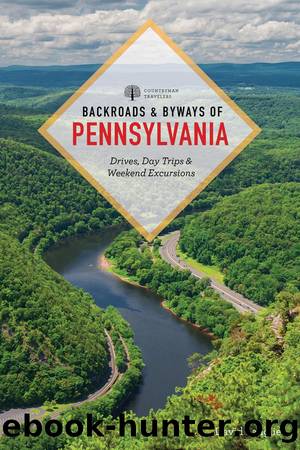Backroads & Byways of Pennsylvania by David Langlieb

Author:David Langlieb
Language: eng
Format: epub
Publisher: Countryman Press
Published: 2020-08-11T00:00:00+00:00
Just past Ohiopyle is a 2-mile detour up a tall, twisting road to Kentuck Knob, Frank Lloyd Wrightâs second-most-famous Laurel Highlands residence. This one belonged to the Kagan familyâice cream tycoons from nearby Uniontown (the final stop on this tour) who befriended the Kaufmanns and managed to commission a Wright house of their own. The innovative residence was built 18 years after Fallingwater, by which time Wright was 86 years old. Kentuck Knob was among the architectâs final private home designs, and he completed the drawings having never seen the project site. With its flagstone flooring, Carolina cypress wood, and locally quarried sandstone built into the natural slope of the land, the residence embodies an aesthetic similar to that of Fallingwater on a more modest scale. Wright enthusiasts will observe signature touches like the low-ceilinged carport and the âcompression and releaseâ approach, which alternates unusually tight entrances and hallways with comparatively expansive spaces. He also plays with shapes, inserting hexagonal skylights into the terrace and outlining the kitchen in the same form. Such creative strokes make the 2,200-square-foot house seem a great deal larger than it really is. Tours take an hour and can be combined with a visit to the groundsâ sculpture meadow and a scenic viewâas fine a place as any to take in the Highlandsâ majesty. Now owned by an English lord who purchased the home in 1986, it is a popular attraction, though not nearly as famous as Fallingwater. It can often be toured without advance reservations.
PA 381 meets US 40 at Farmington. The town marks historically significant Fort Necessity, immortalized as the Fort Necessity National Battlefield and operated by the National Park Service. This tale begins in 1753, when a young George Washingtonâat the time a 21-year-old British military officerâattempted to claim the Allegheny Valley for British colonials. The fertile soil and advantageous location at the forks of the Ohio River made it attractive to the Brits but also to the Native Americans and French colonists who maintained a presence in the area. The regionâs Lenape Indians were especially hostile to the British colonists during this timeâwith the memory of the humane William Penn fading rapidly, the colonists had grown increasingly brazen about forcing the Lenape population west. Meanwhile, the French had established Fort Duquesne at present-day Pittsburgh, signaling an intention to stay. Washington, under orders from Governor George Dinwiddie of Virginia, moved toward Fort Duquesne. En route, his troops launched a surprise attack on Frenchmen camped 50 miles south of the fort. Known as the Battle of Jumonville Glen, this attack ended with the death of a prominent French Canadian captain. The park screens a video dramatizing two versions of Washingtonâs move. The French maintained that the British fired first. Washington claimed the opposite. Either way, it triggered the French and Indian War. After his sneak attack, Washington hastily constructed Fort Necessity at the battlefieldâs present-day site along US 40. A month later the French counterattacked and Washington got pummeled, surrendering Fort Necessity and allowing the French to keep their toehold in western Pennsylvania.
Download
This site does not store any files on its server. We only index and link to content provided by other sites. Please contact the content providers to delete copyright contents if any and email us, we'll remove relevant links or contents immediately.
Hebrides by Peter May & David Wilson(646)
Indians on Vacation by Thomas King(592)
Bill Bailey's Remarkable Guide to British Birds by Bailey Bill(572)
Lonely Planet's Ultimate Travel by Lonely Planet(555)
The Outdoor Knots Book by Clyde Soles(529)
The World's Greatest Mountain Ranges - Geography Mountains Books for Kids | Children's Geography Book by Baby Professor(521)
South From Granada by Gerald Brenan(479)
Best Climbs Los Angeles by Damon Corso(466)
New England Skiing by E. John B. Allen(461)
Hiking Oklahoma by Jamie Fleck(454)
Fodor’s Bahamas by Fodor’s Travel Guides(436)
Sport by Grand Scott(425)
100 Great Wildlife Experiences by Fair James D.;(384)
Baseball in Tampa Bay by A.M. de Quesada(380)
Desolation Wilderness and the South Lake Tahoe Basin by Jeffrey P. Schaffer(372)
A Coney Island Reader by Louis J. Parascandola(370)
Fodor’s Oregon by Fodor’s Travel Guides(369)
Hikertrash: Life on the Pacific Crest Trail by Erin Miller(364)
Hamish's Mountain Walk by Hamish Brown(353)
